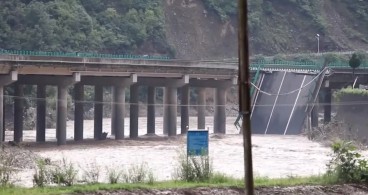Dam Collapse in Sudan: Catastrophic Flooding Leaves 30 Dead, 150 Missing


Sources: ktvz.com, tuko.co, msn.com
Want to read more like this story?

From Aging Infrastructure to Extreme Rainfall: The Growing Importance of Dam Structural Engineering
Oct, 07, 2024 | NewsDams have been integral to human civilization for centuries, playing critical roles in water storag...

Bridge Collapses in Bihar: A Wake-Up Call for Infrastructure Resilience
Aug, 13, 2024 | NewsIncreasing Incidents of Bridge Collapses in Extreme Weather The alarming frequency of bridge colla...

The Devastating Impact and Solutions to Flooding in Brazil
May, 20, 2024 | NewsThe recent catastrophic flooding in Rio Grande do Sul, Brazil, has brought widespread devastation a...

Catastrophic Bridge Collapse in Shaanxi: 15 Dead Amidst Severe Flooding
Jul, 19, 2024 | NewsIn Shaanxi province, a bridge collapse tragically resulted in the deaths of at least 15 people. The...

Catastrophic Mudslides in Ethiopia claimed the lives of at least 229 people
Jul, 23, 2024 | NewsIn an unparalleled disaster, southwestern Ethiopia has faced devastating mudslides that have claime...

Civil Engineering News Recap of August 2024
Sep, 03, 2024 | NewsYou can now find TheCivilEngineer.org's latest news recap video on YouTube, which includes what we...

Dam Burst in Poland Unleashes Destructive Floodwaters
Sep, 15, 2024 | NewsOn September 15, the town of Stronie Śląskie in Poland was devastated by a dam burst, flooding the...

The Devastating Floods in Valencia: A Call for Enhanced Engineering Solutions
Oct, 29, 2024 | NewsThe recent catastrophic floods in Valencia have highlighted the urgent need for better engineering...
Days of heavy rain cause partial collapse of Norwegian dam
Aug, 10, 2023 | NewsPart of a dam at the Braskereidfoss hydroelectric power plant, located on the Glomma River, Norway,...
Trending

Taipei 101’s impressive tuned mass damper

Characteristics of Load Bearing Masonry Construction

Morocco Implements Landmark Dam Perforation to Combat Water Stress in Marrakech

The Line at Neom faces feasibility reassessment while construction continues

Dutch greenhouses have revolutionized modern farming

Suspension bridge buckles under force of deadly super typhoon in Philippines


